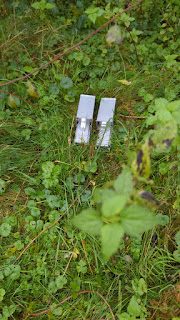Wren (
Troglodytes troglodytes) (
RSPB)
Wrens are the commonest breeding bird in the UK (with a staggering 8.6 million breeding pairs), yet also one of the smallest, hence why they aren't seen as often as many other garden and woodland birds. These guys may be little but they have VERY SHOUTY VOICES! Their noisy rattling call and loud trilling song help attract attention and make up for their diminutive size, and alerted me to the presence of several wrens in a patch of woodland next to the UEA Broad.
With several individuals singing and calling along the stretch of trees, its likely that these were male wrens, defending their territories for the upcoming breeding season which they establish in early spring. In fact, I observed one wren starting to build its nest! Wrens typically build their nests in sheltered spots such as bushes and crevices, and unsurprisingly this one seemed to be frequenting a crevice in the remains of this tree trunk....

He was flying in and out of the stump, often with a beak full to the brim of moss and other material such as twigs to build its domed nest. Wrens have an interesting biology when it comes to breeding habits. Within their newly established territories, male wrens will build a selection of nests in different spots, giving visiting females a wide choice of nest sites should they decide to mate with the male. Once the female chooses her favoured home, the nest will be lined to make a comfy, cosy cocoon for 5-7 eggs to be laid and hatch in a couple of weeks time. Furthermore, being polygynous, the male may mate with multiple females, who can make use of some of the males' empty nests.
Whether the nest in this tree stump will be chosen by a female remains to be seen, or if its proximity to a footpath will put off any potential house hunters. But if the nest is used, it may be possible to follow the pair's breeding progress, which would be fascinating to see!
References:





Comments
Post a Comment